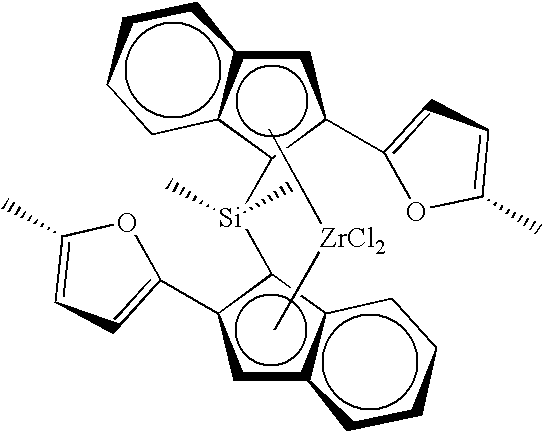Metallocene compound, olefin polymerization catalyst containing the compound, and method for producing an olefin polymer by use of the catalyst
a technology of olefin polymerization and metallocene, which is applied in the field of metallocene compounds, can solve problems such as difficult production, and achieve the effects of easy synthesizing, high yield and high molecular weigh
- Summary
- Abstract
- Description
- Claims
- Application Information
AI Technical Summary
Benefits of technology
Problems solved by technology
Method used
Image
Examples
example 1
[Synthesis of rac-dimethylsilylene bis(2-(2-(5-methyl)-furyl)-indenyl) zirconium dichloride]
(1) Synthesis of 2-(2-(5-methyl-furyl)-indene
In a 500-ml glass reaction vessel, 20 g (0.24 mol) of 2-methyl-furan and 250 ml of THF were placed and cooled to −50° C. in a dry ice-methanol bath. To the cooled mixture, 160 ml (0.24 mol) of a 1.50 mol / L n-butyl lithium-hexane solution was added dropwise. After the dropwise addition, the mixture was allowed to warm to room temperature and stirred for 3 hours. The resultant mixture was again cooled to −30° C. in a dry ice-methanol bath and 100 ml of a THF solution containing 32 g (0.24 mol) of 2-indanone was added dropwise. After the dropwise addition, the mixture was allowed to warm to room temperature and stirred for 16 hours. The reaction solution was cooled to −20° C. in a dry ice-methanol bath and 100 ml of 2N hydrochloric acid was added dropwise. This solution was transferred to a separation funnel and washed with a saline solution until neu...
example 2
Production of Propylene / ethylene Copolymer by the use of Rac-dimethylsilylene bis(2-(2-(5-methyl)-furyl)-indenyl) Zirconium Dichloride
In a 1.5-liter autoclave thoroughly purged with nitrogen, 900 ml of hexane and 1 mmol of triisobutyl aluminum were placed. The mixture was heated to 70° C. while stirring, then fed with ethylene and pressurized to 0.19 MPa, fed with propylene and brought to a total pressure of 0.58 MPa. Thereafter, a metallocene catalyst, which was obtained in advance by mixing 0.001 mmol per Zr atom of the rac-dimethylsilylene bis(2-(2-(5-methyl)-fury10-indenyl) zirconium dichloride synthesized in Example 1 as a metallocene compound and 0.3 mmol in terms of Al atom of methylaluminoxane “p-MAO” made by Tosoh-Akzo Corp. for 10 minutes, was introduced under the pressure of propylene. Polymerization was carried out for 10 minutes at 70° C. under a fixed pressure, with propylene continuously fed to maintain the total pressure at 0.78 MPa. After 10 minutes, the unreacted m...
example 3
Production of Preactivated Supported Metallocene Catalyst by the use of Rac-dimethylsilylene bis(2-(2-(5-methyl)-furyl)-indenyl) Zirconium Dichloride and Production of Propylene Homopolymer
[Production of Preactivated Supported Metallocene Catalyst]
(1) Production of Supported Metallocene Catalyst
In a 500-ml glass reaction vessel purged with nitrogen gas and equipped with a stirrer, 89 ml (267 mmol in terms of Al atom) of a toluene solution of methyl aluminoxane (concentration: 3 mol / liter, “PMAO (trade name)” made by Tosoh-Akzo Corp.) and 0.929 mmol of chiral dimethylsilylene bis(2-(2-(5-methyl)-furyl)-indenyl) zirconium dichloride as an ansa-metallocene compound were placed and reacted while stirring at 25° C. for 15 minutes to obtain the reaction product of the metallocene compound and the aluminoxane, i.e., a metallocene catalyst.
Subsequently, the reaction vessel was charged with 6.7 g of silica having an average particle diameter of 51 μm (“SYLOPOL® 948” made by Grace Davison), w...
PUM
| Property | Measurement | Unit |
|---|---|---|
| Molecular weight | aaaaa | aaaaa |
Abstract
Description
Claims
Application Information
 Login to View More
Login to View More - R&D
- Intellectual Property
- Life Sciences
- Materials
- Tech Scout
- Unparalleled Data Quality
- Higher Quality Content
- 60% Fewer Hallucinations
Browse by: Latest US Patents, China's latest patents, Technical Efficacy Thesaurus, Application Domain, Technology Topic, Popular Technical Reports.
© 2025 PatSnap. All rights reserved.Legal|Privacy policy|Modern Slavery Act Transparency Statement|Sitemap|About US| Contact US: help@patsnap.com



